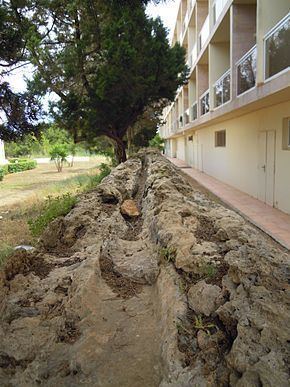Type Roman Fish Farm Condition Ruins Public access Anytime | Founded cica 146 BC Management Consell d'Eivissa Length 425 m Builder Ancient Rome | |
 | ||
Similar Ibiza, Es Caló de S'Algar, Fishing stage, Platja Pou d’es Lleo, Cala Boix | ||
S'Argamassa Roman Fish Farm can be found 2.8 miles (4.5 km) eastwards along the coast from the town of Santa Eulària des Riu on the Spanish island of Ibiza. It is in the municipality of Santa Eulària des Riu. the Romans built this fish farm and connecting aqueduct following their occupation of the island in 146 BC.
Contents
History and location
The Romans arrived to occupy the island of Ibiza after defeating and destroying Carthaginian Empire in 146 BC. The island was granted confederate status with in the Roman Empire and was known as Ebusus Federatae Civitae (Federation city of Ibiza). As a result of this, the island experienced a huge boost to her economy. Salt mining and agricultural activities brought great wealth to the island during this time.
Fishing industry
The islands economy also saw a huge growth in its fishing industry. The fishing technique of almadraba was used in the seas around the island. This used a labyrinth of nets and around fifty boats which channelled huge schools of fish, Tuna being the main catch, in to a holding area. The fish were then culled and dragged aboard the fishing boats. However these catches were so bountiful that not all the fish were killed. Some of the fish were kept alive in aquatic enclosures. There was just this sort of Roman facility, along with a fish processing plant, built at S'Argamassa.
The aqueduct
Leading to the processing plant on the coast, the Romans constructed an aqueduct to carry fresh clean water from a nearby stream to the processing plant. Part of this aqueduct can still be seen today. The conduit is built from large limestone slabs with a channel carved into the top surface. Unfortunately it is rather neglected these days but a 425-meter run of it can still be seen as it runs down to the coast alongside a modern hotel complex.
Production
When the fish surplus was brought to S'Argamassa it was dealt with in two ways. The fish was filleted and then dried and salted. This product was called Salazón. The bi-product of the filleting process were used to produce the Roman delicacy of Garum. Garum is a fish sauce which was consumed in great amounts by the citizens of the Roman Empire. The heads, tails, gills, innards of the fish were first boiled and then macerated in salt, and cured in the sun for one to three months. The mixture fermented and liquefied in the dry warmth, with the salt inhibiting the common agents of decay. Garum was the clear liquid that formed on the top, drawn off by means of a fine strainer inserted into the fermenting vessel. The sediment or sludge that remained was allec. Concentrated decoctions of aromatic herbs might be added. Flavours would vary according to the locale, with ingredients sometimes from in-house gardens.
Fermentation tanks
At the end of the run of the aqueduct close to the shoreline there are the remains of rectangular structures which were once the fermenting tanks for the production of the Garum. On completion of the process the sauce was packed into enormous earthenware storage jars called amphoras, also produced locally, and exported to all parts of the empire. The sauce was hugely popular condiment and was the ketchup or soy sauce of its day.
